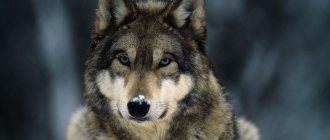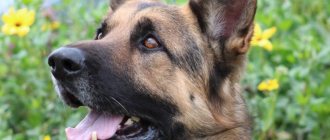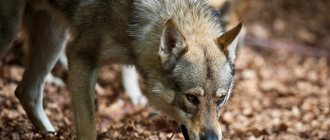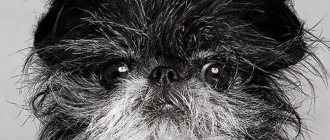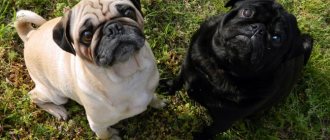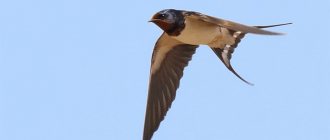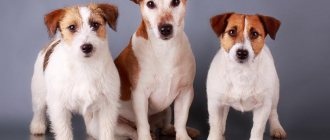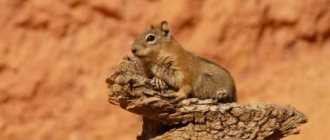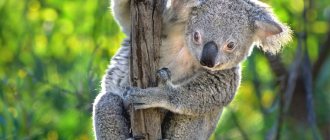The Central Asian Shepherd Dog (Alabai) is a working dog bred in Central Asia. The breed is used to protect livestock, guard housing and property, and perform military tasks. The dog is popular in Asian republics; it is no less common in Russia. Alabai is a strong and large animal. It is capable of surviving in the most extreme conditions.
Alabai is a strong and large dog that is used for protection.
History and origin of the Alabai breed
Experts believe that the Central Asian Shepherd appeared 3-6 thousand years ago. The ancient breed has retained its original characteristics. This is confirmed by a terracotta figurine discovered during excavations of a settlement that existed approximately 4 thousand years ago. The figurine is made in the form of an alabai with cropped ears and tail.
The breed was formed over a large territory, which explains the differences in names - Caucasian wolfhound, Turkmen Alabai. The dog was common in the regions of the Southern Urals, Pamirs, and Alatau. Now there are several states located in these territories.
The most accurate name from a geographical point of view is “Central Asian Shepherd Dog”. The breed is registered under this name.
The descendants of modern Alabais were bred for grazing and guarding livestock. The tribes needed dogs characterized by strength, endurance, courage and ease of care. All these features are characteristic of a graceful animal with a proud look and cat-like movements. The breed expanded beyond Central Asia around 1930. XX century Professional breeding began later. This led to the preservation of the original appearance: people did not have enough time to make fundamental changes.
The dog contains qualities inherent in thousands of years of natural selection. The breed standard “Turkmen Alabai” was approved in 1990. In Russia the animal is called the “Central Asian Shepherd Dog”. When classifying, they use the FCI standard No. 335 of 1989. No changes have been made to the document since then. The purebred wolfhound is recognized as the heritage of Turkmenistan. It is prohibited to take it out of the country.
The Central Asian Shepherd is a very ancient breed.
Varieties
Within the Alabai breed, they are divided into so-called native species and hybrids. The former are the result of nomadic life. The second is the result of unsuccessful selection, which was carried out during the Soviet Union. There are four native species, and at least two type species. Each of them is described in more detail in the table below. The starting point is the smooth-haired Turkmen Alabai, which is considered the primary type of the breed.
Table - Aboriginal and type species of the Turkmen wolfhound
| Name | View | Peculiarities |
| Coplon leopard | Aboriginal | - Has a willful character; - practically impossible to train; - lives in Central Asia |
| Alabai | — Considered an urban variation of the wolfhound; - has relatively small dimensions | |
| Tibetan alabai | Hybrid | — Not a pedigree (a product of crossing with a Tibetan mastiff); - has a small population |
| Caucasian Alabai | It is considered a species that arose by crossing the Turkmen wolfhound with the Caucasian shepherd dog |
Another species not included in the table is the so-called Turkish alabai. It is relatively young and has recently started appearing on the market. The history of the appearance of the species still remains a mystery even to professionals. In addition, in Turkmenistan there is a species - the long-haired alabai. True, it is not officially recognized either. Therefore, Central Asian shepherd dogs with long hair in this country, according to documents, are mongrels.
In some sources, the terms “Caucasian Alabay” and “European Alabay” refer to individuals with cropped ears.
Description of Alabai
The dog has a balanced body with high withers and strong muscles. The back is short and straight, but strong, the loin is slightly elevated. The croup is wide, with well-developed muscles. The neck is powerful and muscular, but short. The breed is characterized by small, low ears. They are not purchased in all countries; it all depends on the standards and approved norms. Massive and powerful jaws, with teeth arranged like a guillotine, provide a strong grip. The lower part is covered with fleshy lips. Fractures of individual incisors do not affect a dog's bite.
Alabais are characterized by a symmetrical large head with a blunt muzzle that does not taper towards the nose. The flattened skull has an occipital protrusion. The intelligence of the Central Asian Shepherd is quite well developed. Dog handlers rate mental abilities at 4 points out of a maximum of 5. The dog’s mental and nervous state is quite stable. An animal rarely shows aggression without a reason.
Before the attack, the pet begins to growl. When the enemy does not react, when provoked, the alabai quickly attacks.
The dog is touchy, it has a sense of self-esteem. The pet must be respected, then it will become a devoted friend. It is advisable to start training immediately after purchasing a puppy. Character begins to develop in the first months of life.
Lifespan of a dog
At home, Alabai lives 12–15 years. This is a lot for a large breed. Life expectancy depends on care and living conditions. With timely treatment of diseases and moderate physical activity, the dog's health lasts longer. Cases have been recorded of Alabai living up to 17 years. The owner's inattention and poor care negatively affect the pet's condition. A large dog begins to age earlier than a small one.
Life expectancy at home is 12-15 years.
If in other breeds life expectancy does not depend on gender, then in Alabais this is not the case. Bitches often exhibit pathological infertility, when an animal in heat does not allow a male dog to approach and cannot become pregnant. The disease eventually leads to the development of pyometra. Inflammation of the uterus causes early death of the dog. If the owner does not plan to become a breeder, he needs to sterilize the pet.
Alabais were bred to live outdoors, so unfavorable conditions and frequent weather changes do not affect life expectancy. Living in a simple crate makes for a happier and healthier dog. Keeping them on a chain does not have the best effect on the health of the animal. Obesity, joint diseases, and mental disorders reduce life expectancy.
What group does the breed belong to?
The Central Asian Shepherd is considered a Molosser or Wolfhound. This group includes the Caucasian Shepherd, Giant Schnaucher, Georgian Nagazi and some other dog breeds.
Puppy cost
The price of a dog depends on the following factors:
- Appearance of the animal. Experts identify several types of Alabais. Prices can vary by tens of thousands of rubles.
- The presence or absence of signs of marriage. Buyers who want to become a professional breeder or take part in an exhibition pay attention to this factor.
- Puppy color. Pure white specimens are considered more valuable.
The cost of a puppy depends on appearance and color.
The cost is also determined by the location of the breeder. Prices in large cities are higher. The size of the puppy does not affect the price. The minimum price for alabai is 13 thousand rubles. For that kind of money you can buy an individual with signs of breeding. A simple-looking puppy costs 20 thousand rubles.
For a dog with a good pedigree and an unusual color, you will have to pay more than 50 thousand rubles.
Exterior of the Alabai breed
The dog is characterized by a harmonious physique, tall stature, and a moderately elongated body. Gender differences are well expressed: males are more massive than females, they have larger heads.
Dimensions and weight
The dog is characterized by large overall dimensions. The height of a male is 65–78 cm, that of a female is 60–69 cm. The weight of a male reaches 79 kg. Females have smaller parameters. The average weight of a female is 50 kg.
Muzzle and head
The standards describe the following characteristics of a purebred dog:
Alabai has a massive head and neck.
The head is massive, but proportional to the body. The shape is close to a rectangle. The length of the head is 40% of the height at the withers. Dogs with voluminous long heads are preferable. Slightly curved zygomatic arches give the muzzle a rectangular shape.- The skull is deep, the forehead is flat and long. The frontal tubercle is prominent, but the muscles slightly hide it. The depth of the skull is equal to its width. In a young individual, the frontal bone may protrude slightly. This feature is not considered a disadvantage. However, the title is not given to an unformed dog.
- The brow ridges are smoothed. However, too little development of such elements may be associated with a convex forehead and round eyes. Strongly protruding arcs create the appearance of a sharp transition. Both signs are considered deficiencies. A long, smooth transition with a wide bridge of the nose is welcome.
- The large black nose does not protrude beyond the contours of the muzzle. The skin may be lighter with a white coat color. Physiological lightening of the nose in dogs occurs in winter. Bitches' skin becomes discolored after nursing puppies. These natural processes should not be confused with a motley nose, which is considered a defect.
- The dog's lips are thick, they tightly cover the jaws. It is desirable that the skin and mucous membranes in this area be black. The upper lip should not fluctuate during movements or fall into the mouth.
- Pockets form in the corners of the mouth. However, a drooping lower lip is considered a defect.
- The dog's jaws are wide and powerful. White, tightly fitting teeth must be presented in full (42 pieces). Duplication of the first premolar is allowed. The presence of broken incisors that do not affect the bite is allowed. The disadvantage is that the teeth are too small. A dog cannot receive a breeding assessment even if a premolar is missing.
- The dog's eyes are oval in shape and medium in size, with a color ranging from light to dark brown.
- The ears are triangular, hanging, low set. The bottom edge of the base is at eye level. Many owners crop their dogs' ears unless such a procedure is prohibited by law.
- The neck is massive, of medium length. A special feature of the breed is the dewlap. It protects the dog's vital blood vessels from enemy bites.
Body build and tail
The pet has a powerful muscular body, a voluminous chest with rounded ribs. The loin is wide and short, slightly prominent. The back is straight and strong, the stomach sags slightly. The tail, thick at the base, is set high. When at rest, it has the shape of a ring.
Alabai is distinguished by a voluminous chest with a wide lower back.
Docking is not considered a defect unless prohibited by national standards.
Limbs
The front legs are characterized by moderate length and strong joints. Tough skin and fleshy pads make the dog's gait soft and smooth. The fingers are equipped with strong claws. The hind legs are set wider than the front legs. Strong bones and strong hips provide high running speed and a strong push when jumping. The pads of the hind feet are covered with thick skin. The claws are hard and not sharp. The dog's movements are balanced, the joints are quite mobile.
Alabai coat and color
The animal's body is covered with thick, coarse hair. The undercoat is well developed, protecting the dog from the cold. There are short-haired (hair length up to 5 cm) and long-haired (up to 7 cm) types of alabai. The second type is characterized by the presence of a mane on the neck, islands behind the ears, on the paws and tail. Any color is allowed, with the exception of sable, brown and blue.
Disqualifying faults
Significant deficiencies are identified by experts who take into account the breed standards adopted in the country. Vices include:
Dryness of physique is a vice.
looseness or excessive dryness of the physique, muscle weakness;- paws too high;
- stretched or shortened torso;
- narrowness and weakness of the withers;
- short, disproportionate or too large head;
- low height at the withers;
- prominent cheekbones, a sharp transition from forehead to nose;
- pointed muzzle;
- folded skin on the head, hanging lips;
- spotted or too light nose;
- severely damaged, sparse incisors;
- prematurely worn teeth covered with yellow plaque;
- close-set, slanting eyes;
- high-set, undocked ears;
- short hair, lack of undercoat;
- long neck with a weak muscle frame;
- sagging, hunchbacked or narrow back;
- sheep, excessively shortened neck with large dewlap;
- sunken, protruding or flat lower back;
- high rear part of the body, short narrow croup;
- underdeveloped, barrel-shaped chest;
- straight or inverted stomach;
- sharp, steep or short blades;
- weakness of the elbow and wrist ligaments;
- straight shoulders;
- deformities of the hock and knee joints;
- cow-like, barrel-shaped, close-set paws;
- violation of parallelism of limbs;
- deformation of paw bones, soft metacarpus and metatarsals;
- unbalanced movements that cannot be corrected;
- increased excitability, inhibition, uncertainty in behavior.
Characteristics of the Alabai breed
Before buying a puppy, you need to study the behavioral characteristics of such dogs.
Behavior and character
Alabais are a calm breed. They are confident, loyal, proud and smart. Security guard skills are demonstrated at an early age. The dog carefully looks after the territory, exploring every corner. Alabai becomes the best security guard of a country house. He is brave and fearless in battle. When a male trespasses, he attacks without warning, while a female barks at the enemy first.
The dog selflessly defends its territory. Such an animal does not attack without reason. With proper upbringing, Alabai can live in families with children.
Intelligence and training
Training is aimed at eliminating dominant habits. Training should be entrusted to a professional; the correct approach is extremely important, it protects against mistakes. Trainings are held daily and last about an hour. With proper training, the puppy begins to understand basic commands within six months. It is difficult to get an Alabai interested in training; you will have to make an effort. The learning process becomes more effective if the animal is interested. You need to reward the puppy with treats, praise it more often and show care.
Training will be effective if the animal is interested.
Bitches are more difficult to train. Females know many ways to deceive their owner. Males are easier to train, their character is less complex.
Is he aggressive?
A properly raised dog does not show aggression towards strangers and other animals. However, she is always on guard, ready to protect. When the enemy does not calm down, the alabai attacks. If a dog shows aggression for no reason, he needs to be punished.
However, it is not worth using physical methods. Aggression in a dog can occur when kept on a chain.
How does Alabai treat children?
A dog will never attack a child without reason. In addition, the animal does not divide children into “strangers” and “us”. A properly raised Alabai will become a child’s best friend and protector. To avoid dangerous situations for children, you need to:
- explain to the child that it is forbidden to hit or jerk the dog;
- teach the dog to treat all family members with respect;
- Do not let a small child walk with an adult dog.
Compatibility with other animals
Alabai is friendly towards dogs. He protects less powerful individuals as he would in a pack. A shepherd can also get along with a cat. However, the owner must treat all pets with equal care. If a cat or dog does not feel loved, hostility will begin.
Alabai can easily get along with a small kitten.
Maintenance and care of Alabai
The dog requires regular walks, proper nutrition and hygiene.
In the apartment
The room in which the Alabai lives must be spacious. A one- or two-room apartment will not be suitable for keeping such a dog. The animal loses activity, which causes obesity. Excess weight leads to dangerous diseases.
On the street
If a dog lives in the yard of a private house, an enclosure is built for it. The following recommendations are taken into account:
- the animal’s home should be located in a place protected from the sun and wind;
- the booth for rest and sleep should be spacious;
- You need to ensure that no sharp protrusions or rusty elements appear in the fence.
Walking scheme
A dog living in a house or apartment is taken outside 2 times a day. Each walk should last at least 2 hours.
An alabai walk should last at least two hours.
Before being taken out, the dog is put on a muzzle and a leash. If the animal lives in the courtyard of a private house, a walking area will be provided. Every 3 m, posts 35–40 cm high are driven in. These devices are used by animals when cleaning their bodies.
Grooming and hygiene
To clean the wool, use a medium-hard brush. The comb should remove dirt but not damage the skin. Before starting the procedure, a massage is performed: the dog’s body is stroked against the grain for 3 minutes. After the massage, the brush is led in the same direction. After this, the coat is combed with a fine comb in the direction of hair growth. This procedure normalizes blood circulation and increases muscle tone.
You need to bathe your dog once a month in summer and spring. The wool is thoroughly wetted, after which shampoo is applied. It is recommended to use special products that do not irritate the skin. Foam or water should not get into the ears, eyes or nose. You can dry the wool with a hairdryer if the dog has been accustomed to the noise of the device since childhood. A shepherd dog living in a country house is bathed outside in the summer by watering it with a hose. If the animal is kept in an apartment, its paws are washed after every walk.
Caring for Alabai also includes periodic cleaning of the eyes and ears, and prevention of helminthic infestations.
Sleeping area
It is worth preparing a comfortable place for the puppy to sleep and rest. It should be located as far as possible from sources of cold and heat. This way the dog will get accustomed to its place and will not lie down on the owner’s sofas and beds.
The dog's sleeping place should be comfortable for sleeping.
Nutrition and diet
Alabai are given both ready-made food and natural food. Dry food is combined with treats and canned food. Be sure to have fresh drinking water in a bowl. Dogs love tasty and fresh natural food. The diet should include:
- fish fillet;
- raw meat;
- milk and fermented milk products;
- offal;
- eggs;
- vegetables;
- cereals
Dogs eat porridge and soups with meat well. The diet should not include:
- spices;
- smoked products, sausage;
- poultry and pork;
- bones;
- legumes;
- sweets.
Ways to increase the lifespan of dogs
Those mongrels who are luckier live in apartments. They are looked after, walked, and taken to the veterinarian. With such care, an animal can live up to 15 years or longer. Yard dogs do not always receive proper care, so their life expectancy is much shorter. But you can try to fix everything, the main thing is to monitor your diet, living conditions and regularly visit the veterinarian.
On a chain
Most often, yard dogs are put on a chain, thus limiting physical activity. This leads to a reduction in life expectancy. Under such living conditions, the animal can live no more than 8-12 years. If it is necessary to limit the dog’s movement, it is better to put him in an enclosure. But if this is not possible, then to keep the mongrel comfortably on a leash it is worth providing:
- presence of a booth;
- proper nutrition;
- carrying out regular vaccinations;
- periodic walks;
- constant access to drinking water.
There is an opinion that street dogs live much longer than purebred dogs because they are adapted to changing weather conditions, but this is all a myth. Every day the mongrels get wet in the rain and freeze in the cold. The absence of a kennel or other place in the yard guarantees that the dog will develop health problems.
Keeping a dog on a chain
Therefore, if the dog lives on the street, he needs to ensure a comfortable existence by building a booth
In addition, it is important to monitor nutrition, regularly vaccinate and walk
Thus, without normal nutrition, a yard dog will not live long. Just like a thoroughbred, he needs care and attention. Therefore, if you see a stray dog walking down the street, you should not pass by, but you should try to place him with a family or give him to a shelter, where he will be provided with full care, extending his life to 15 years.
Mating and breeding of Alabai
Puberty in this breed begins earlier than physiological. A female dog's first heat can occur at 8 months. A male dog becomes sexually mature at 12–16 months.
Puppies are bred from animals over 2 years old.
However, animals that have reached 2 years of age must be bred. The dog should be walked on a short leash to prevent it from meeting a member of the opposite sex. Early mating negatively affects the health of the female and cubs. Weak, non-viable puppies may be born. You should not breed older animals either.
Photo
Next in the photo you can see what an Alabai’s enclosure should be like and the approximate dimensions of a dog house.
Health and common diseases of Alabai
Hereditary pathologies and immune problems are rarely found in these dogs. However, the pet is not insured against other diseases. The following problems occur:
- Pathologies of the musculoskeletal system. Heavy weight puts stress on the joints. The result is dysplasia or arthritis.
- Obesity. This disease is typical for dogs living in apartments. A balanced diet and physical activity help to avoid excess weight.
- Worm infestations. Deworming using special preparations should be carried out every six months.
- Diabetes. Develops due to metabolic disorders. Your pet should not be given sweets or other foods not intended for dogs.
- Damage to skin and fur by ectoparasites. It is necessary to use sprays and collars that repel fleas and ticks.
Diet
The diet of the breed should include soups and solid foods. In winter, bran should be added to the menu, and in summer - vegetables and herbs. The basis of the diet should be meat. You can use offal or tough beef. It is important for dogs to maintain healthy teeth, and for this it is necessary to eat tough food. It is very important not to overfeed your pet as this can lead to digestive problems. Ideally, a healthy dog's ribs should not protrude, but they can still be easily felt. Alabais are ideal dogs for keeping in private homes. Apartments are a bit cramped for such dogs.
How to choose a puppy
When buying a dog, consider:
- Puppy age. It is better to buy 2-month-old cubs. Puppies must have all vaccinations and documents confirming their pedigree.
- Age of parents. The puppy's mother must be at least 2 and not older than 8 years old. This also applies to the father.
- Gender of the puppy. You need to decide in advance who to buy. Girls are more active and emotional, boys are brave.
- Puppy behavior. You need to choose a cub that responds well to sounds and voices. It is easier to make friends with such an animal.
- Appearance. A healthy Alabai has a shiny coat, a moist nose, and a clear look. The legs should not be too short or long.
When buying an Alabai puppy, age, gender and behavior are taken into account.
Age compared to human years (table)
| Alabai age | Person's age |
| 1 year | 15 years |
| 2 years | 24 years |
| 3 years | 28 years |
| 4 years | 32 years |
| 5 years | 36 years |
| 6 years | 45 years |
| 7 years | 50 years |
| 8 years | 55 years |
| 9 years | 61 years old |
| 10 years | 66 years old |
| 11 years | 72 years old |
| 12 years | 77 years old |
| 13 years | 82 years old |
| 14 years | 88 years old |
| 15 years | 93 years old |
Pros and cons of the Alabai breed
The advantages of the dog in question are:
- good security and defense skills, intelligence;
- attachment to the owner and his family members, calm attitude towards children;
- neatness, no need for daily bathing;
- standard diet;
- survival in any conditions;
- kindness, lack of aggression.
Disadvantages include:
- dimensions that do not allow keeping a pet in small apartments;
- the need for complex training (the dog can become aggressive if improperly raised);
- leadership tendencies that can interfere with learning;
- instinct to dig holes;
- heavy shedding in autumn and winter;
- intolerance to humid air.
Interesting facts about Alabai
Some people don't know that:
- Alabais are among the ten largest breeds.
- The dog Bulldozer has the heaviest weight. The dog lives in Russia and weighs 125 kg.
- The word "alabai" is translated as "pockmarked" or "motley".
- As a form of protest, the dog may relieve itself in inappropriate places.
- The breed is prohibited in some countries because it is considered a fighting breed.
- Alabais are present in the films “Okhlamon”, “Makar the Pathfinder”.
- In Uzbekistan, dogs are called Buribasars, which translates as “wolfhound”.
- Small puppies love to bite, which is due to the presence of an innate hunting instinct. During training, you need to eradicate this habit.
- The dog is capable of severely injuring unfamiliar animals or people entering its territory.
Despite the fact that the Alabai is considered a good companion and assistant, it should be owned by a person who has the patience and time to train.
Owner reviews
Frankly speaking, not everyone is able to have such a breed in a city, and here, if the owner copes with all his responsibilities properly, a monument should be erected to him; such a person himself must be provided for and stand firmly on his feet financially, first of all, in terms of. Not to mention personal responsibility.
Those who have endured and are still bearing on their shoulders all the hardships associated with close friendship with the Alabai (read, living together with him and properly caring for him), first of all note that these dogs are certainly smart, and if they bark, then only for the sake of business, to “further ostracize” the stranger, and that with proper upbringing, such a dog can rightfully be called golden.
They also say that in the city such dogs do not live to their middle years and die at the age of nine and ten.

